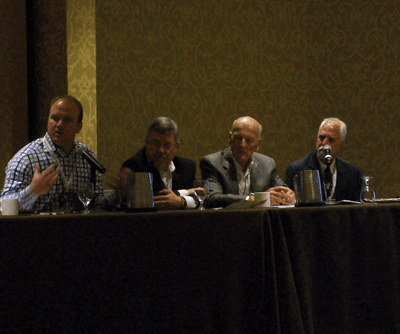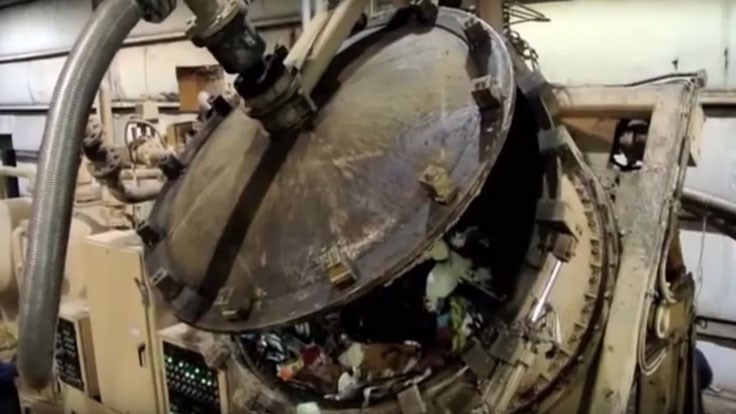From a new mixed-waste processing facility in Alabama to a biofuels facility in Canada, several projects in North America are integrating multiple processes into their management of the solid waste stream. During the Renewable Energy from Waste Conference, Nov. 17-20, 2014, in San Jose, California, several project developers shared how their projects are unfolding.
 |
| Panelists as the 2014 Renewable Energy from Waste Conference discuss integrated waste management projects. From left, Kyle Mowitz, cofounder and CEO, Infinitus Energy; Bud Latta, director for business planning and central operations, waste management services, city of Edmonton, Mike Muller, BioGas Equity 2 Inc.; and Todd Green, general manager waste to energy landfill, American Waste Control. |
Bud Latta, the city of Edmonton, Alberta’s director for business planning and central operations, waste management services, discussed the components of the 550-acres Edmonton Waste Management Centre and how it fits with the city’s strategic plan. The center includes 12 waste processing facilities, two research facilities, a closed landfill and sewage biosolids storage/recycling lagoons.
In the early 1990s Edmonton began searching for a new landfill because it was close to reaching capacity, said Latta. After a 10-year search, the city was no closer to finding a new landfill and it worked on a 30-year strategic plan that included more robust recycling and composting and seeking private-sector involvement to provide capital and share the risk.
In the early 2000’s the city stepped up its efforts to maximize diversion through composting, evaluating residuals for refuse-derived fuel (RDF), moving to curbside recycling for multifamily dwellings and targeting institutional, commercial and industrial (ICI) waste and construction and demolition(C&D;) debris.
In the 1990’s, the city targeted a 70 percent diversion rate for the residential waste stream, and today Edmonton’s diversion rate goal is 90 percent. In 2003, the city began exploring the option of turning waste into biofuels. After years of reviewing technologies, obtaining permits and grants and receiving regulatory approval, construction on the biofuels facility began in 2010 and was commissioned in 2014. The owner and operator of the waste-to-biofuels facility, Montreal-based Enerkem, was only a few weeks away from start-up as of the conference.
Latta joked that Edmonton had waited 10 years for the project so they were willing to wait another few weeks.
The city of Edmonton owns and operates the Integrated Processing and Transfer Facility (IPTF), which processes the feedstock used in the biofuels facility. The biofuels facility is expected to be in full operation in 2015. The city is also working on an anaerobic digestion (AD) project that it expects to be running in 2017.
Mike Muller, of BioGas Equity 2 Inc., Woodside, California, discussed a project under construction in Grove City, Ohio, for the Solid Waste Authority of Central Ohio (SWACO), which is being developed by Team Gemini of Orlando, Florida.
Team Gemini was selected by SWACO to develop 365 acres next to a landfill. During the first phase of the public-private partnership, Team Gemini is tasked with building a center of resource recovery and recycling (COR3). SWACO and Team Gemini will share in the cost of new related roadways and the scale house. SWACO is required to divert municipal solid waste (MSW) to COR3. Material that cannot be recycled will be used in the AD and gasification process in phase two.
Team Gemini and SWACO signed three agreements. The first was a land development and operating agreement for the term of the leases. The second agreement was for a 99-year lease for 22 acres of property adjacent to the landfill and the third agreement was a 99-year lease for 343 acres directly across the road from the landfill.
Muller emphasized that a streamlined permit process accelerates the adoption of projects. “You can’t steal second base with your foot on first,” he noted.
Kyle Mowitz, cofounder and CEO of Infinitus Energy, Plantation, Florida, discussed the Infinutus Renewable Energy Park (IREP) Montgomery, a mixed-waste processing facility in Montgomery, Alabama, which opened in April 2014.
Mowitz said paper and polymers from the facility can be converted into engineered fuel (EF) or recycled. He said the ability to produce an EF provided ultimate flexibility, depending on the markets for baled materials. “You have to be nimble and change quickly to respond to the market,” he said. “Bale quality is very high coming out of the facility,” he added.
He told attendees that as of May 2014 the facility was recovering 90-plus percent of recyclables, including:
- plastics, 96 percent;
- mixed paper, 95 percent;
- old corrugated containers (OCC), 97 percent;
- tin/steel, 94 percent; and
- aluminum cans, 90 percent.
“I’m here to tell you that the quality is very high and we’ve had no rejected loads as of now,” he said.
The acceptance test performed by a third party in May also confirmed a processing rate of 32.36 tons per hour and an overall waste diversion rate greater than 60 percent.
Once all the phases of the facility are implemented, Mowitz estimates the facility will have an overall recovery rate of 60-85 percent. He added 95 percent of organic fraction will be converted and taken to a compost and AD system during the second phase.
During phase two, Montgomery’s collection fleet will be converted to use compressed natural gas (CNG) produced at the AD facility. “The city will actually operate the first carbon-negative fleet in the country,” said Mowitz. The facility is saving the city an estimated $1.6 million and once the fleet conversion takes place, the city will be saving about $2.2 million, according to Mowitz.
Todd Green, general manager of Tulsa, Oklahoma-based American Waste Control’s (AWC’s) waste-to-energy landfill shared what he called “a true American success story.”
He told of how Kenny Burkett founded the business with one borrowed truck back in 1970 and now has more than 100 trucks, employs more than 200 people, services more than 2,000 commercial customers and generates more than $50 million per year in revenue.
In 1987 the company began the first recycling transfer station in Oklahoma that it called Tulsa Recycle and Transfer (TRT). American Environmental Landfill was purchased in 2000 and is now a renewable energy landfill.
“The three companies have come together with one common goal in a very competitive market and that is to provide the most cost effective, environmentally sound solution to the clients that we serve,” said Green.
TRT began its public-private partnership by serving 130,000 residential homes transitioning to single-stream recycling, said Green. Bulk Handling Systems, www.bulkhandlingsystems.com Eugene, Oregon, helped TRT with a $10 million upgrade to its material recovery facility (MRF) in order to handle the recyclable material, which includes glass, paper, plastics and aluminum and steel cans.
“We are now able to process with a 95 percent recovery rate the single-stream recyclables brought in from the city of Tulsa,” said Green.
Green also talked about raising awareness by having more than 400 drop-off containers throughout the community, which also generate additional revenue. The company created a mascot named Mr. Murph because, as Green put it, “education is everything.” He attributes these efforts to a 22 percent reduction in the residential waste stream.
The landfill was designated by the Oklahoma Department of Environmental Quality as the most compliant landfill in the state, according to Green. For the landfill-gas-to-energy project, AWC formed a private partnership with Pittsburgh-based Montauk Energy.
“I like to call it the ‘They pay, we play program,’” Green said. He explained, Montauk paid for the drilling of 67 wells at the landfill’s generating station. Green said this gave AWC time to secure right-of-way easements prior to the plant being built. AWC also secured a purchase agreement with the Oklahoma Municipal Power Authority for the power.
The facility runs two Cat 35-20 engines at 1.6 megawatts each. It has been operating since 2012 with the only downtime being for oil changes, according to Green. The facility provides power to 4,500 homes. AWC controls 60 percent of the market in an area where the largest haulers in the country are active - something that led Green to conclude, “I think we’ve achieved our goal.”
“The Integrated Model” session was moderated by Jim Miller, CEO of JR Miller & Associates, Brea, California.



